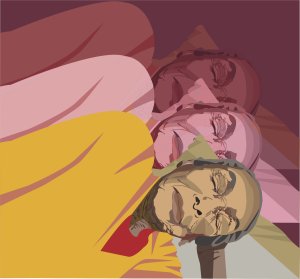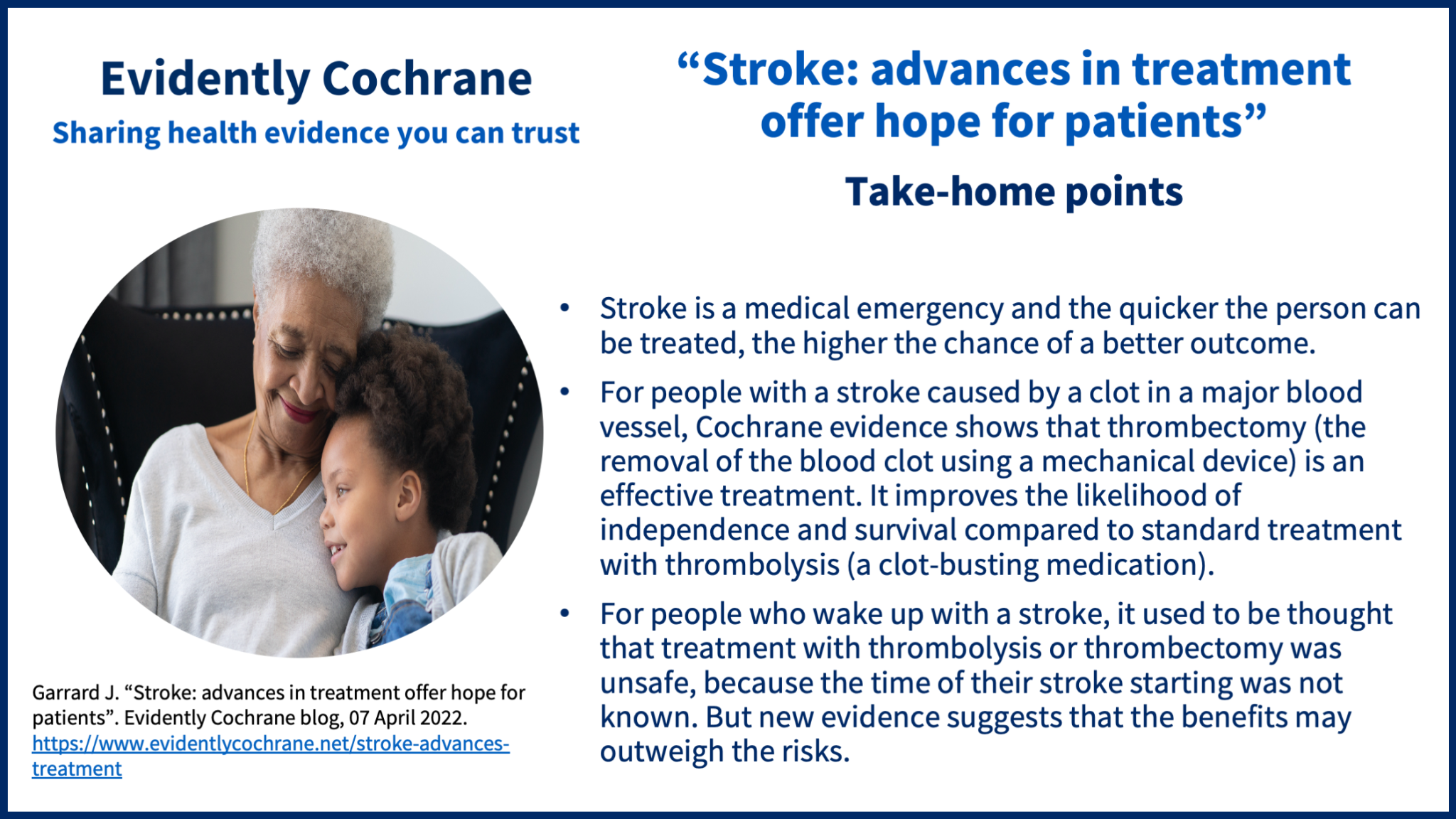In this blog for people interested in stroke treatmentSomething done with the aim of improving health or relieving suffering. For example, medicines, surgery, psychological and physical therapies, diet and exercise changes., James Garrard, Specialist Registrar in Stroke and Geriatric Medicine, reflects on his experience as a doctor working in a stroke centre and looks at the latest evidence and some game-changing developments in treatments for some stroke patients.
Take-home points
Stroke is common. In the UK, every 3 and a half minutes will see another person having a stroke. It’s the second leading cause of death worldwide and the third leading cause of disability. Most strokes result from disrupted blood flow due to a blood clot, called ischaemic stroke. This blog is about treatment for this type of stroke.
Stroke is a medical emergency, and time really matters. From the time symptoms start, over 1 million neurons (nerve cells) die every minute. Time really is brain.
For clinical staff working in a hospital setting, the bleep of a pager going off signals a need to jump into action quickly. As a trainee stroke physician, working in a regional stroke centre, this means I have a suspected stroke patient on their way to the hospital. By meeting them directly, my aim is to assess and treat stroke patients as quickly as possible.
Emergency treatment for stroke
Having rapid access to a scanner, immediate consultant input, and expert nurses experienced in giving urgent treatment are all things that help stroke patients get treated fast. This has been shown to improve their chance of survival and ability to return home.
I quickly assess the timing and severity of symptoms, to make a diagnosis of stroke.
Other health conditions the patient has, medications, and their baseline level of function are all vital pieces of information I need to assess what treatments can be given. Specific stroke treatments are limited, and only safe if given to the right patients. For most stroke patients, specialist multidisciplinary treatment on a dedicated stroke unit provides the best chance of survival and regaining independence, as suggested by a Cochrane ReviewCochrane Reviews are systematic reviews. In systematic reviews we search for and summarize studies that answer a specific research question (e.g. is paracetamol effective and safe for treating back pain?). The studies are identified, assessed, and summarized by using a systematic and predefined approach. They inform recommendations for healthcare and research. of Organised inpatient stroke unit care in 2020. This is the standard medical care for stroke patients in the UK, which is continually monitored on a national level to try and improve the standard of patient care.
Unfortunately, stroke remains a devastating disease. Despite the best medical care, as many as 4 in every 10 patients who suffer a stroke die within the first year, with many more left to learn to live with long-term disability. Providing support to patients and families with difficult decisions about treatment and care after stroke is hugely important, and is discussed in more detail in an Evidently Cochrane blog on Living and dying well after stroke.
Getting rid of the clot: thrombolysis and thrombectomy
Thrombolysis is medicine given through a vein to dissolve the clot causing disruption to blood flow. It needs to be given within 4.5 hours of the stroke happening. Thrombolysis carries a risk of bleeding into the damaged area of brain and after this time the risk of bleeding outweighs the potential benefit. Around 20% of strokes can be treated with thrombolysis.
If a major blood vessel is blocked, it can result in a significantly disabling stroke. This is known as a large vessel occlusion and accounts for around 10% of all strokes. Intravenous thrombolysis often struggles to dissolve the clot, given its size. For these patients, it might be possible to manually remove the clot using a newer technique called thrombectomy. This is done by expert radiologists using X-ray guidance in a theatre setting.
Removing the blocked blood vessel using thrombectomy can result in instant return to blood flow to a significant portion of the brain. This has a much greater chance at restoring blood flow than thrombolysis alone.
Given that the two are very different in how they work, many patients who receive thrombectomy will be treated with thrombolysis first.
Evidence that thrombectomy is a game-changing treatment
A Cochrane Review Endovascular thrombectomy and intra-arterial interventions for acute ischaemic stroke (June 2021) has found reliable evidence that thrombectomy reduces the riskA way of expressing the chance of an event taking place, expressed as the number of events divided by the total number of observations or people. It can be stated as ‘the chance of falling were one in four’ (1/4 = 25%). This measure is good no matter the incidence of events i.e. common or infrequent. of death and improves the chance of a person being independent, without increasing the risk of bleeding. On average, if six patients are treated with thrombectomy, one more will be independent following their stroke. This is based on studies looking at people with a large vessel occlusion ischaemic stroke, treated within 6 hours of symptoms.
Such new treatments rarely occur in medicine these days, and this provides a real game-changing approach to stroke treatment, but is only possible in patients with a blockage to one of the major blood vessels supplying the brain.
For many patients, thrombolysis is the only treatment option to try and restore blood flow. At best, 10 patients must be treated with thrombolysis to get one more who will be independent again, and only if we can treat them within the first three hours after their stroke. If we can only give thrombolysis between 3 to 4.5 hours after a stroke, we’ll have to treat 19 patients to get one more who will be independent again.
What about people who wake up with a stroke?

Around 1 person in every 5 who have a stroke will have it in their sleep. With the timing of the stroke happening unknown, it used to be thought that treatment with thrombolysis or thrombectomy was unsafe for these patients. But new evidence suggests that the benefits may outweigh the risks.
A Cochrane Review Intravenous thrombolytic treatment and endovascular thrombectomy for ischaemic wake‐up stroke (December 2021) has found reliable evidence that both thrombolysis and thrombectomy improve the chance of a patient regaining independence when used for patients who wake up with stroke symptoms, compared with standard stroke unit care.
On average, if three people who wake up with a stroke are treated with thrombectomy, one more will regain independence. This is much better than with thrombolysis, where twelve patients need to be treated for one more to regain independence. Thrombolysis appears to increase the risk of bleeding into the damaged brain, with an average of one more person having a significant bleed for every fifty patients treated.
What next?
Improving access to treatment
Given that thrombectomy is done by expert radiologists, it cannot be provided in every hospital. This means that services have had to begin to change to improve access to thrombectomy services. For patients who wake up with stroke symptoms, access to the right scans and expertise in analysing the images is needed to ensure the treatment can be given to the right patients.
For me as a stroke physician, thrombectomy provides me with a very effective treatment option for patients who have the more severe strokes. It allows me to offer a much better chance for my patients to survive and recover their independence. However, identifying which patients are suitable for treatment remains a key area of ongoing research and focus for improvement.
Further information and support
How can you tell if someone is having a stroke?
Whilst the likelihood of someone having a stroke increases with age, stroke can affect people of any age. Michael Johnson, an Olympic athlete and Andrew Marr, a BBC journalist famously have suffered from strokes at a young age. Thankfully, both have made good recoveries. This is a short clip of Andrew Marr talking about his experiences.
Stroke is a medical emergency, and any patient experiencing symptoms of a stroke should seek urgent medical attention.
It is important for everyone to be mindful of signs or symptoms of a stroke because, as discussed earlier, time is brain.
Recognising symptoms of stroke can drastically improve the outcomeOutcomes are measures of health (for example quality of life, pain, blood sugar levels) that can be used to assess the effectiveness and safety of a treatment or other intervention (for example a drug, surgery, or exercise). In research, the outcomes considered most important are ‘primary outcomes’ and those considered less important are ‘secondary outcomes’.. Act FAST:
- Face – has their face fallen on one side? Can they smile?
- Arms – can they raise both their arms and keep them there?
- Speech – is their speech slurred?
- Time – time to call 999
Public health campaigns, such as the FAST campaign, have helped improve the identification of stroke by members of the public, and have resulted in a greater proportion of patients receiving acuteA health condition (or episodes of a health condition) that comes on quickly and is short-lived. treatment for stroke.
- Read more trusted information about stroke on the NHS website
- Access support and information on the Stroke Association website
- Read more Evidently Cochrane blogs on stroke
James Garrard has nothing to disclose.
Join in the conversation on Twitter with @jamie_garr @CochraneUK or leave a comment on the blog.
Please note, we cannot give medical advice and do not publish comments that link to individual pages requesting donations or to commercial sites, or appear to endorse commercial products. We welcome diverse views and encourage discussion but we ask that comments are respectful and reserve the right to not publish any we consider offensive. Cochrane UK does not fact check – or endorse – readers’ comments, including any treatments mentioned.



